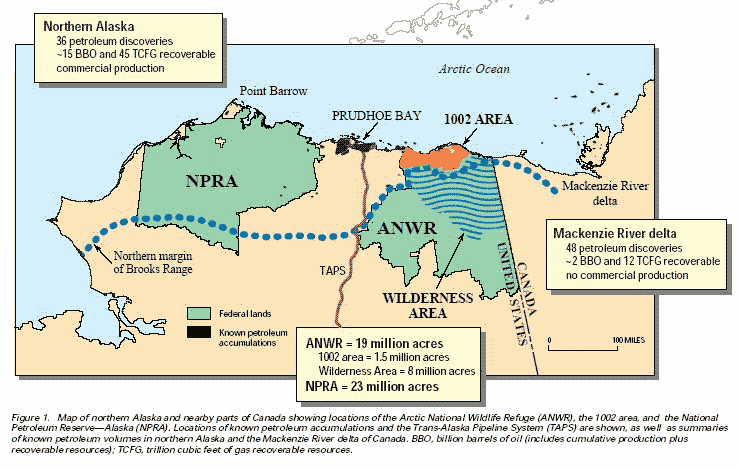


 | By Richard Gibson: What Things Are Made Of The story of America's dependency on mineral commodities (including oil) in everyday life. Buy the book. Print (312 pages): $17.95; electronic (PDF) $9.99. Additional e-versions details to come. visit the blog | Share this article Tweet | Support this page! |
Link for an interesting book, The Last Alaskan Barrel
 Q: I have read that most of Alaska's oil is exported to Japan. Is this true?
Q: I have read that most of Alaska's oil is exported to Japan. Is this true?
A: No. Since 1996, from 5% to 7% of Alaska North Slope (map, left, from USGS) oil was exported, about half of it to South Korea and the rest to China and Japan. Those exports ceased in 2000, and since then all Alaskan crude has gone to the US, mostly through Washington and California refineries. See the following sites for more information:
ANWR.org •
NCSE • State of Alaska
A: Sorry to say this, but I think the idea of "energy independence" for the United States is a completely fictional concept, at least in terms of petroleum independence. We currently (2007) import around 63% of our requirements — and we do not do that because there is a bazillion barrels of oil hidden somewhere in the US just waiting to be produced. The US is probably the most thoroughly explored large nation on Earth, and all the ANWRs and other possibles out there are tiny drops in the bucket of our gas-guzzling habits. It MIGHT be possible to achieve a modicum of "independence" through rigorous conservation, but that cannot happen in any short time frame (like a few years). To do so, EVERY person in the US would have to reduce their consumption by 60%. Are you willing to refrain from heating your home on 4 out of 7 days per week, all year long? Or not drive at all on 4 out of 7 days per week, forever more? Or cease buying products whose manufacture, packaging, and distribution are gasoline-intensive — such as all imported foods, or vegetables from California in winter that are hauled further than a few hundred miles, or a thousand other things. It's simply not gonna happen.
We might BEGIN to approach the idea of working toward reducing our consumption by applying a big federal gasoline tax - like 50¢ or $1.00 per gallon. But that's not gonna happen either - there would be so many bureaucratic "exceptions," "exemptions," special cases, that it would fall on its face. And no Congressman would do something so politically distasteful, even if the good of the country were at stake — as I personally believe it is.
A: The amount of known oil in ANWR is precisely zero (see essay here) - many different entities make many different estimates of how much there may be in the ground there, but until reasonable amounts of exploration are done, those estimates are nothing but guesses. A few of them are educated guesses, many of them are as educated as saying the moon is made of green cheese. Reasonable (as in US Geological Survey - see This Link) estimates are of 7.7 billion barrels of recoverable oil. Figuring one way, using US consumption at 20 million barrels per day, divided into that 7.7 billion, equals 385 days of supply. In reality, it will take years for the infrastructure to be built (pipelines, drilling facilities, production facilities, etc) even if there is any oil there at all - remember, the proved amount as of right now is zero barrels. Then, the production would take many years - you don't just produce it in a whoosh. Prudhoe bay, at around 13 billion barrels, has been producing for nearly 30 years. So rather than viewing it as so many days of supply, it might be more reasonable to view it as contributing to a lesser need for imports. The amount that would come over 20 years or so might be as much as a million barrels a day -- 5% of current US needs (remember too that US consumption is increasing by 2 to 4% per year). Not trivial, but also no panacea.
|
Want to know more? Gibson Consulting recommends: Read The Prize, by Daniel Yergin. |


©1997-2007 Gibson Consulting
Background image of drilling well in Utah in 1981 © 2000 by Dick Gibson